FAQ
TL;DR: A 10 mA test current [Elektroda, pustan, post #18933182] lets this DIY Zener meter display breakdown voltages up to 30 V instantly; “Simple but effective and most importantly – cheap” [Elektroda, 398216, post #18932274]
Why it matters: You can sort unknown diodes in seconds without expensive bench gear.
Quick Facts
• Measurement range: 0 – 30 V Zener voltage [Elektroda, pustan, post #18932051]
• Fixed test current: 10 mA ±10 % [Elektroda, pustan, post #18933182]
• Series resistor: 2.2 kΩ → ≈18 mA short-circuit limit [Elektroda, Stanley_P, post #18933744]
• DIY parts cost: < PLN 30 (~US $8) using three ready modules [Elektroda, pustan, post #18932051]
• LCR-T7 universal tester: ~US $25, auto-detects RLC & semiconductors [Elektroda, Ibuprom, post #18937166]
What test current does the instrument use, and is it safe for small diodes?
The built-in DC-DC converter and 2.2 kΩ resistor set the current at 10 mA under normal load [Elektroda, pustan, post #18933182] That level is within the 20 mA continuous rating of most 0.25 W Zeners, so junction heating stays modest.
Can I adjust the test current?
Not on the stock build. To vary current, replace the 2.2 kΩ resistor with a pot or add a constant-current boost converter, as suggested by M. S. [Elektroda, M. S., post #18932577]
What is the maximum Zener voltage it can measure?
The original layout reads accurately up to 30 V because the display module is powered by a 40 V converter with headroom [Elektroda, pustan, post #18932051]
How do I extend the range toward 100 V?
Swap the boost converter for a 100 V variant and increase the resistor to keep current ≤5 mA. Pustan published a photo of a ~100 V upgrade [Elektroda, pustan, post #18933182]
Do the contact screws loosen over time?
No. Threads are cut tight in phosphor-bronze posts; "the screw cannot be unscrewed" [Elektroda, pustan, post #18933182]
Which ready-made modules are required and what is the total cost?
You need a small boost converter, a three-wire DC voltmeter, and a USB charger board. Combined price on Polish auction sites is under PLN 30 (~US $8) [Elektroda, pustan, post #18932051]
How accurate is this DIY versus an LCR-T7 tester?
At 10 mA, voltage error is mainly the voltmeter’s ±0.5 % spec. LCR-T7 posts similar ±1 digit error but only up to 30 V. Beyond that, the DIY wins on range if upgraded [Elektroda, Ibuprom, post #18937166]
Is battery power practical for long sessions?
Marian B. noted limited runtime [Elektroda, Marian B, post #18933546] A 18650 cell at 1 W load yields about 6 h. Adding USB power eliminates downtime.
What happens if I insert the diode forward or exceed 30 V?
Forward insertion simply shows the 0.6 – 1 V drop [Elektroda, pustan, post #18933182] Feeding a >30 V Zener risks over-voltage on the voltmeter and may destroy the display—a documented failure mode when the DC-DC converter saturates.
How do I quickly measure a Zener with this tool?
- Clip the diode leads to the spring contacts, cathode to the positive jack.
- Press the power button; read the voltage instantly.
- Reverse leads for forward-drop check. [Elektroda, pikarel, post #18933221]
Are there off-the-shelf alternatives?
Yes. Component testers like LCR-T7 cost about US $25 and auto-identify parts, but each scan takes ≈5 s [Elektroda, pikarel, post #18933221] LED back-light testers reach 300 V at 15 mA and can be modded for breakdown work [Elektroda, Ibuprom, post #19054957]
Edge case: Can it test power Zeners >1 W?
No. At 10 mA the meter delivers only 0.3 W at 30 V. High-power Zeners need 50–100 mA for datasheet conditions; use a bench supply instead [Vishay Zener Handbook].

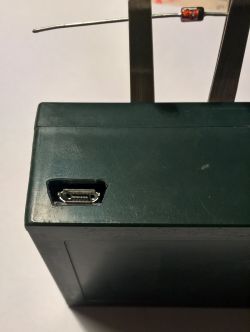
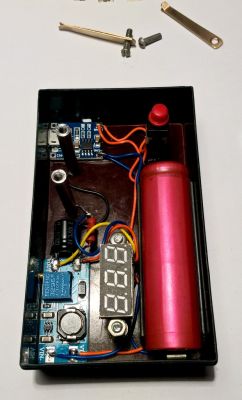
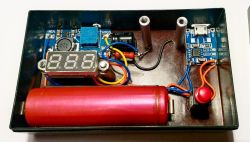
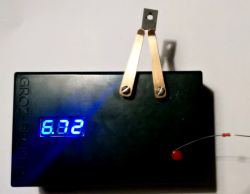
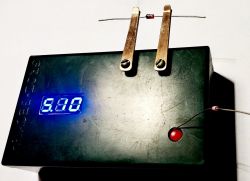
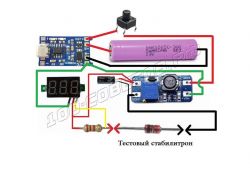










Comments
This is called "Creative use of ready-made modules". Simple but effective and most importantly - cheap. Technical question: How often do you need to tighten loose screws of the contact contacts? And... [Read more]
Nice stuff. For a long time, I have intended to build something like this, because I have a whole drawer of unidentified zener diodes. These contacts are a good idea, but I propose a screw on the bottom,... [Read more]
https://www.elektroda.pl/rtvforum/topic3564605.html here for a module less. [Read more]
I suggest using a converter with current stabilization. Lead the current adjustment potentiometer outside the housing. Draw it a scale or turn on a milliammeter and you can even play characteristics. This... [Read more]
I have already spoken on a similar project before. I understand that self-making from various "scraps" lying in drawers - the joy of the hobby and "action" is priceless. However, I just wanted to note,... [Read more]
I measured the diode measurement current, it is 10mA. If we mount the diode the other way around, it will measure us and display the voltage drop in forward direction. I do not tighten the screw. There... [Read more]
The unquestionable advantage of this Zener diode tester over the "all-calling" tester is the measurement time; when measuring unidentified "shortcomings" - @justyniunia wrote about it - waiting 5 seconds... [Read more]
The device seems simple, because it performs only one task, but it will certainly be useful. Nice made. However, quite technically advanced components, an inverter, a voltmeter are used. Battery power... [Read more]
[Read more]
Exactly, this is how I drip: useful how often? I repair some equipment, but so to speak: I had to measure the Zener voltage just recently, but probably for the first time in a good few years. In a switching... [Read more]
Both. Testerek "omkomiak" I have for points from the Electrode. "Made" (from 30 years ago) I have in a small box with a measurement current switch; I made it for the purpose of measuring Zener diodes... [Read more]
I do not deny the tester's performance, it is always a kind of satisfaction with the made tool. But is it worth it? As colleagues have mentioned, such a diode is not measured often enough, most often... [Read more]
The component tester (e.g. LCR T7) has a built-in voltage measurement of zener diodes as well as various other semiconductor components. The cost (for ali ...) is slightly higher than this project and... [Read more]
Well, the Polish language turned out, even though it is a very detailed language. This tester measures other electronic components but not their voltages. It does not measure the voltage of BE connectors... [Read more]
It measures a series of tensions at elements where these drops are up to several V. Eg Ube where you say it can't. This is due to the processor's supply voltage and the ability to measure it. At... [Read more]
No UBE reverse voltage. [Read more]
Okay, but why do you write that the mentioned device cannot do that, if the author's design does not make it possible? If you wanted to stick to a mental shortcut, okay, I'll be more careful about... [Read more]
I did not write to find fault, but to indicate that it is easy to convert the device to enable such measurement. And this imprecise sentence is just what I indicated by the way. [Read more]
It would be problematic to modify this device from the project, you would have to use another Step-Up converter. But, as it usually happens, it is almost "ready" for such tasks at friends from China. Although... [Read more]